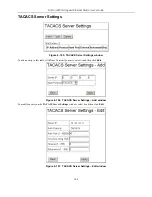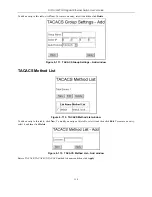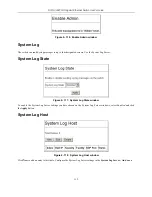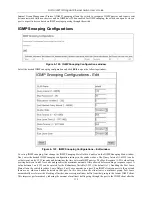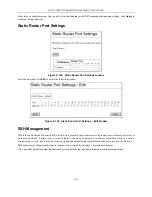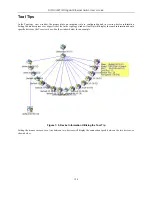
DGS-3224TGR Gigabit Ethernet Switch User’s Guide
119
This window can be used to specify user name, authentication method, host name, and host IP.
SSL Management
Secure Sockets Layer or SSL is a security feature that will provide a secure communication path between a host and client
through the use of authentication, digital signatures and encryption. These security functions are implemented through the
use of a
ciphersuite
, which is a security string that determines the exact cryptographic parameters, specific encryption
algorithms and key sizes to be used for an authentication session and consists of three levels:
1. Key
Exchange:
The first part of the cyphersuite string specifies the public key algorithm to be used. This switch
utilizes the Rivest Shamir Adleman (RSA) public key algorithm and the Digital Signature Algorithm (DSA),
specified here as the
DHE DSS
Diffie-Hellman (DHE) public key algorithm. This is the first authentication process
between client and host as they “exchange keys” in looking for a match and therefore authentication to be accepted
to negotiate encryptions on the following level.
2. Encryption:
The second part of the ciphersuite that includes the encryption used for encrypting the messages sent
between client and host. The Switch supports two types of cryptology algorithms:
Stream Ciphers – There are two types of stream ciphers on the Switch,
RC4 with 40-bit keys
and
RC4 with 128-
bit keys
. These keys are used to encrypt messages and need to be consistent between client and host for optimal
use.
CBC Block Ciphers – CBC refers to Cipher Block Chaining, which means that a portion of the previously
encrypted block of encrypted text is used in the encryption of the current block. The Switch supports the
3DES
EDE
encryption code defined by the Data Encryption Standard (DES) to create the encrypted text.
3. Hash Algorithm
: This part of the ciphersuite allows the user to choose a message digest function that will
determine a Message Authentication Code. This Message Authentication Code will be encrypted with a sent
message to provide integrity and prevent against replay attacks. The Switch supports two hash algorithms,
MD5
(Message Digest 5) and
SHA
(Secure Hash Algorithm).
These three parameters are uniquely assembled in four choices on the Switch to create a three-layered encryption code for
secure communication between the server and the host. The user may implement any one or combination of the ciphersuites
available, yet different ciphersuites will affect the security level and the performance of the secured connection. The
information included in the ciphersuites is not included with the Switch and requires downloading from a third source in a
file form called a
certificate
. This function of the Switch cannot be executed without the presence and implementation of
the certificate file and can be downloaded to the Switch by utilizing a TFTP server. The Switch supports SSLv3 and TLS
v1. Other versions of SSL may not be compatible with this Switch and may cause problems upon authentication and
transfer of messages from client to host
Download Certificate
This window is used to download a certificate file for the SSL function on the Switch from a TFTP server. The certificate
file is a data record used for authenticating devices on the network. It contains information on the owner, keys for
authentication and digital signatures. Both the server and the client must have consistent certificate files for optimal use of
the SSL function. The Switch only supports certificate files with .der file extensions.




